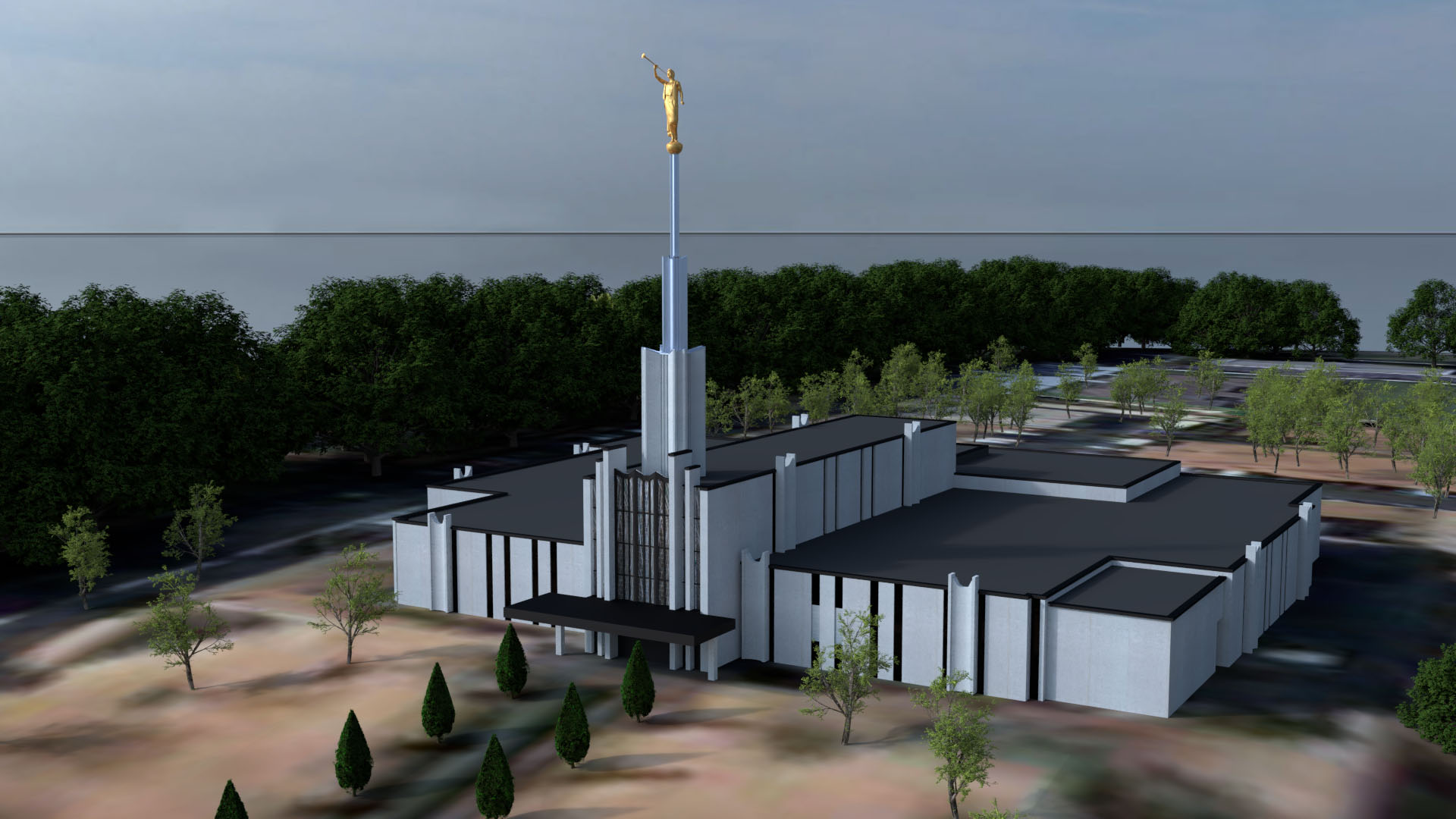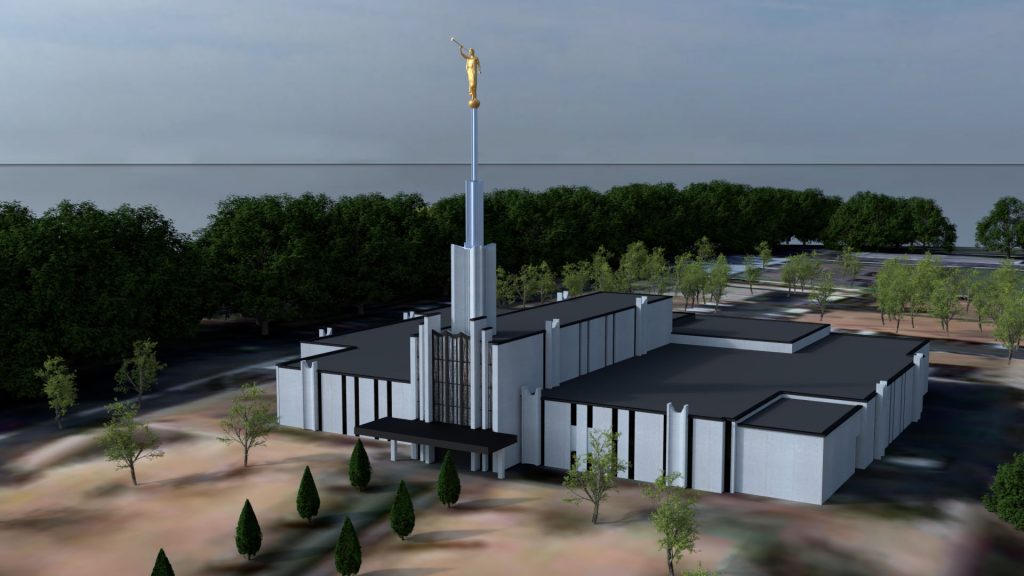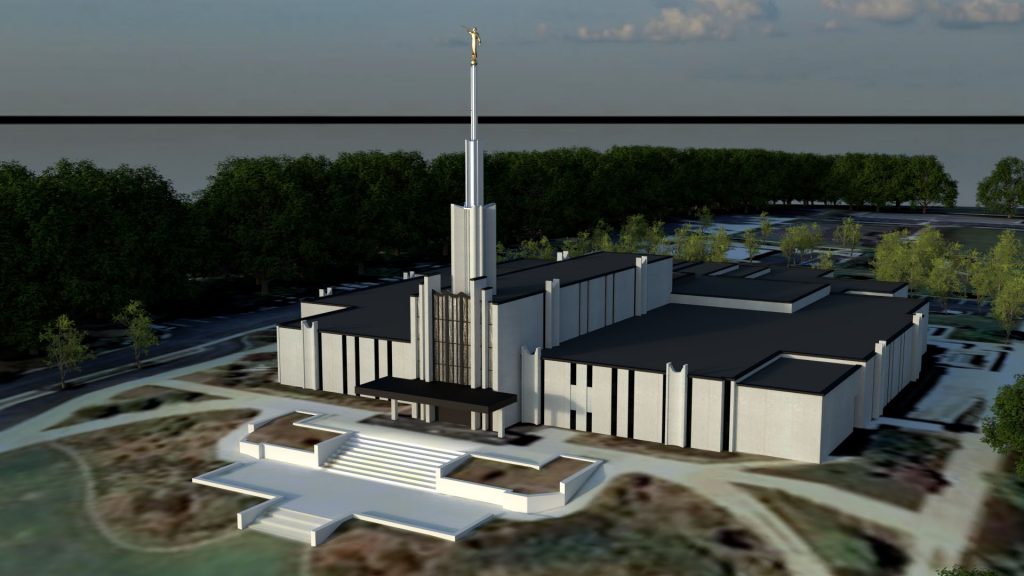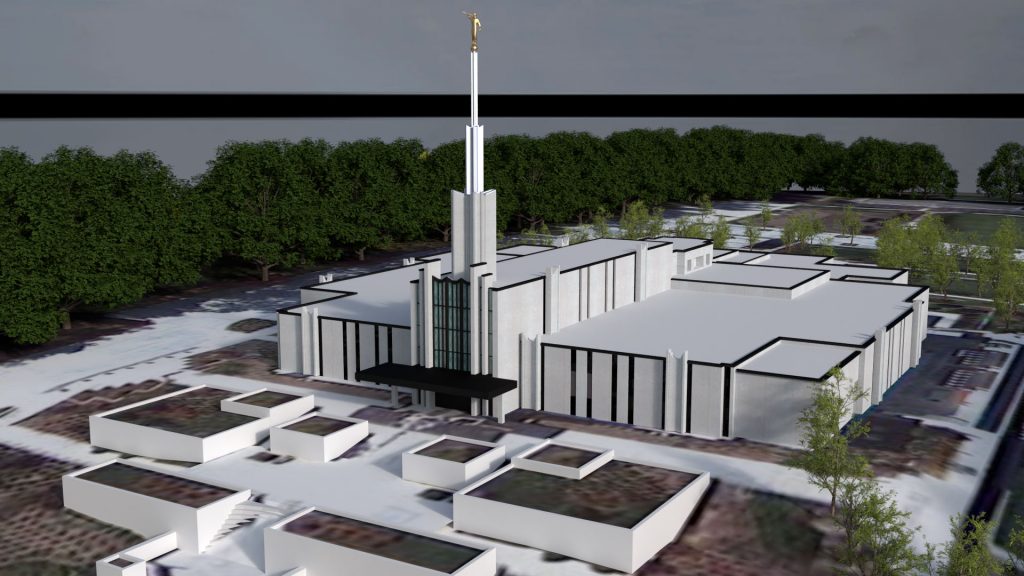
Atlanta Georgia Temple Wiki
Description
The Atlanta Georgia Temple (formerly the Atlanta Temple) was the first temple built by the church in the Southeastern United States and the second temple east of the Mississippi River since 1846.
Prior to the construction Latter-day Saints in the South traveled to either the Washington D.C. Temple or to other temples throughout the United States to be married, sealed to children or parents, receive blessings collectively known as the Endowment, or perform ordinances on behalf of deceased ancestors.
The original area served by the temple included approximately 150,000 Latter-day Saints encompassing the states of Georgia, Florida, Alabama, Mississippi, Tennessee, South Carolina, and portions of North Carolina, Louisiana, and Arkansas.[ref name=”conkey”]Conkey, Donald S. (August 1983), “News of the Church”, Ensign: 72[/ref]
Until the dedication of the Orlando Florida Temple in October 1994 members of the church in the Caribbean also came to the Atlanta Temple.[backref name=”conkey”] During the first decade of the Atlanta Temple’s operation it was not unusual for Latter-day Saints from Venezuela and other South American countries to come to the Atlanta Temple (Flights to Atlanta were often cheaper than those to Mexico City, Lima Peru, or Guatemala City where the church dedicated temples in the early 1980s. Temples were dedicated in Bogotá Colombia in April 1999 and Caracas Venezuela in August 2000).
History
1843 – Elder John U. Eldredge, preached in Georgia en route from Alabama to North Carolina.
1876 – Elder John Morgan organized a branch in Haywood Valley near Rome, Ga.
1879 – Rome, Ga., about 60 miles north of Atlanta, became headquarters of the Southern States Mission.
1879 – Elder Joseph Standing was killed when a mob attacked him and his companion, Elder Rudger Clawson, near Varnell’s Station in northern Georgia.
1901 – Missionaries, who had been directed to focus more of their work in the cities, baptized Julia Mozell Love, the first convert in Savannah.
1908 – A branch was organized and a meetinghouse was constructed in Atlanta. In 1928, President Heber J. Grant dedicated a new and larger brick meetinghouse that replaced the original building.
1937 – Homer Yarn, a local member, was called as president of the Georgia District of the Southern States Mission.
1957 – Elders Mark E. Petersen and LeGrand Richards of the Quorum of the Twelve organized the Atlanta stake, the first stake in Georgia. William Nichols was its president.[1]”Atlanta Georgia Temple: Highlights of Church History in Georgia,” Church News. 7 May 2011.
Announcement
The announcement to build a temple in Georgia was made by the church’s First Presidency in April 1980.[2]“Church Launches Worldwide Temple-Building Emphasis with Announcement of Seven New Temples,” Ensign, May 1980.
A site for the temple was selected on a 13-acre (53,000 m2) lot in Fulton County, in the then-unincorporated city of Sandy Springs, between Barfield Road on the east and Glenridge Drive on the west, 3.5 miles (5.6 km) north of Atlanta.
Groundbreaking
Ground breaking ceremonies were held on March 7, 1981, with church president Spencer W. Kimball presiding. An estimated 10,000 spectators were in attendance.[3]Kimball, Spencer W. (May 1981), “A Report of My Stewardship”, Ensign: 5[4]”Ground Broken for Atlanta Temple”, Church News, p. 3, March 14, 1981
Special guests at the ground breaking included Georgia Governor George Busbee, Georgia Speaker of the House Tom Murphy, Joe Frank Harris, United States Senators Jake Garn and Paula Hawkins, United States Congressman Elliott Levitas, State Senators Nathan Dean, Joe Thompson, Joe Burton, and Wayne Garner, State Representatives Bill Cummings and Doug Vandiford, and Fulton County Commissioner Michael Lomax.[5]Kimball, Vera Edna Browning (1984), The Southern Miracle, p. 160
In his remarks at the groundbreaking, Busbee commented on the high emphasis Latter-day Saints place on education within the family and the positive impact the temple would have on the state;
I wish more Georgians placed such importance in the moral aspects of this life, for only through a common responsibility for our neighbor’s well-being can we insure that our state will be a better place for our children to live.
And we are all taking a big step toward that goal on this beautiful hillside today as we break ground on what will soon be the first Mormon Temple in the entire Southern United States.[6]Kimball, Vera Edna Browning (1984), The Southern Miracle, p. 180
Construction
The building contract was awarded to Cube Construction, Inc.[7]Temple Update, 1 (1): 1, December 1981 and over the next two years the property was developed to include the temple, an annex (including facilities for grounds keepers), a clothing distribution center, and a small apartment building for missionaries and other out-of-state temple workers. In 1988 the property was further developed to include a meetinghouse (chapel) for regular Sunday worship and other church activities.
The Atlanta Temple was the first of seven smaller temples built in the early 1980s. Its dimensions were smaller than previous temples and the original designs did not include a spire.[8] “News of the Church”, Ensign: 75, March 1982[9]. The originally proposed design for the Atlanta Georgia Temple fell short of “Mormon Temple” status in the eyes of a Faith & Values reviewer for the Atlanta Journal-Constitution, who noted the absence of a spire and gold angel. However, at a regional meeting held in Tucker, Georgia, on January 10, 1982, church architect Emil B. Fetzer announced the addition of a spire including a 11-foot-6-inch (3.20 m) statue of the angel Moroni.[9]Temple Update, 1 (2): 1, February 1982. This commenced a tradition of including a spire and angel Moroni on nearly every successive Latter-day Saint temple.
Open House
The Mormon temple was open for public tours 3 May through 21 May the 1983. 60,000 people toured the temple during the 10 day open house, an average of 3,529 people per day. The first day of the open house was reserved for VIP guests including various local leaders and baseball legend Dale Murphy of the Atlanta Braves—himself a member of the Church.
Dedication

The Atlanta Temple was dedicated in services held on June 1–4, 1983, by Gordon B. Hinckley.[10]2006 Church Almanac, Deseret Morning News, 2005, p. 513-515. It was the first temple dedication of 98 dedications or rededications presided by President Hinckley.
In the dedicatory prayer, Hinckley affirmed the sacred nature of the temple in these words:
May all who enter its portals realize that they are entering Thy house as Thy guest, and conduct themselves always with reverence and respect and love for Thee.
May all who enter these holy precincts feel of Thy spirit and be bathed in its marvelous, sanctifying influence… May they come with clean hands and pure hearts and in a spirit of love and dedication. May their minds be lifted above the mundane affairs of the world to a higher and more heavenly plane. May any spirit of selfishness or unkindness or evil whose influence may affect them in the world, leave them when they enter the doors of this sacred and holy sanctuary…
May the very presence of this temple in the midst of Thy people become a reminder of sacred and eternal covenants made with Thee. May they strive more diligently to banish from their lives those elements which are inconsistent with the covenants they have made with Thee. Wilt Thou bless them, dear Father, with peace in their hearts and peace in their homes.”[11]Church News, 5 June 1983 p. 4–5.
The Atlanta Georgia Temple was the first temple dedicated by President Gordon B. Hinckley, who went on to dedicate or rededicate 89 other temples.
The Temple was hailed as being a “space-age marvel of electronics.”[12]Hill, Doris, “New space age temples,” Cloverdale Reveille, 8 December 1982, p, 17. Notable among the technological wonders that this temple had were computer systems networked to Church records in Utah, display terminals, and Infrared wireless headphones, systems used in many temples since.
Dedicatory Prayer
Dedication Order
The Atlanta Georgia Temple was the first temple built in the Southeastern United States (and in Georgia).
Expansion

At the dedication of the Atlanta Georgia Temple, President Hinckley promised that the baptistry would one day be enlarged. That promise was fulfilled 14 years later when a renovation project enlarged the baptistry, added offices, and remodeled the waiting rooms. On 14 November 1997, Hinckley rededicated the temple.[13] Official Atlanta Georgia Temple page
Renovation
The First Presidency announced on 4 April 2009, that the temple would close on July 1, 2009, for 15–18 months of renovations.[14]”Mormon Population Grows Dramatically in South Church Building Temples in 7 Southern Cities”, The Commercial Appeal, November 27, 1999. The interior was reconfigured included to feature high ceilings in the foyer, a nonpatron waiting room, a high-capacity sealing room, progressive ordinance rooms with murals, and art glass illuminated with daylight-style artificial lighting in the Celestial Room and a new vaulted ceiling with large windows at the top. Clothing rental was removed, and food vending was relocated. Changes were included making the temple more accessible to those with special needs. The crystal from the original Celestial Room chandelier of the Atlanta Georgia Temple was crushed and incorporated into the Celestial Room art glass windows of the remodeled temple. Marble from the original altars was laid into the pulpit of the chapel.[15]“News Release”, Newsroom, LDS Church, May 1, 2011
New works of art is a mural in the creation room by Linda Curley Christensen[16]Jenkins, Rob (April 12, 2011), “Remodeled Georgia Atlanta Temple features exotic materials, natural light”, Church News.
“This renovation included complete replacement of the electrical, plumbing and HVAC systems, as well as the installation of an automatic fire sprinkler system. Work was also done to assure more complete functionality for the disabled. In addition to the technical improvements, new appointments include rich eucalyptus hardwood from Brazil, original art, Swarovski crystal chandeliers, 45 new art-glass panels, etched carpets and added windows for increased natural light. The exterior of the temple remains mostly unchanged, with some new landscaping.”[17]“Church President Thomas S. Monson Rededicates Atlanta Georgia Temple After Renovation,” MormonNewsroom.org
Moroni Replaced
Moroni Resumes His Position Atop the Atlanta Georgia TempleThe Atlanta Georgia Temple has been closed since July 1, 2009, for a complete remodel of the interior and relandscaping of the grounds. Progress on restoring the building was evident recently when the angel Moroni statue was replaced atop the spire March 4, 2010 . Construction is expected to continue for most of the year.
Night Lighting Returned
The Atlanta Georgia Temple was once again lit at night on February 10, 2011 with the return of exterior floodlighting .
Rededication announced
The First Presidency announced the open house and rededication dates for the Atlanta Georgia Temple on January 28, 2011.
Open House
When construction was completed, a public open house was held from April 9 through April 23, 2011.[18] “News Release”, Newsroom, LDS Church, January 28, 2011. The temple was rededicated on May 1, 2011, by church president Thomas S. Monson.[19]“News Release”, Newsroom, LDS Church, May 1, 2011
Cultural Celebration
There was also a cultural celebration featuring music and dance on Saturday, 30 April 2011. The cultural celebration was held at the Atlanta Civic Center. Youth performers from 150 area congregations danced, sang and presented a visual display of Georgia history and culture in “Southern Lights.” Two thousand seven hundred young people participated in the celebration, mastering challenging dance and musical numbers. Other Church leaders were in attendance, including Elder M. Russell Ballard, Elder Walter F. González and Elder William R. Walker.
Open House
Before the rededication, the temple was opened to the public for tours. The open house was scheduled from Saturday, 9 April 2011, until Saturday, 23 April 2011, excluding Sundays.During the 13 days of the open house the temple was toured by 56,000, an average of 4,308 people per day.
Rededication

The temple was formally rededicated on Sunday, 1 May 2011 in two sessions by President Thomas S. Monson. Both of the rededicatory sessions were broadcast to congregations of the Church within the temple district.
Presidents
| Temple President | Years Served |
|---|---|
| David H. Ingram | 2018– |
| Lyle J. Stucki | 2015–2018 |
| Stephen D. Posey | 2012–2015 |
| K. Dean Black | 2007–2012 |
| J. David Echard | 2004–2007 |
| C. Eugene Carroll | 2001–2004 |
| Heber S. Branham | 1998–2001 |
| James E. Hill Sr. | 1995–1998 |
| Gerald L. Scott | 1992–1995 |
| A. Harold Goodman | 1989–1992 |
| David H. Yarn Jr. | 1986–1989 |
| Robert M. Winston | 1983–1986 |
Details
The Temple measures 198 feet (60.35 meters) at its widest point, and 212 feet (64.62 meters) at its longest point. It is 34,500 square feet (3,205.15 square meters) in size.
Prior to the 1997 expansion the temple measured 160feet (48.77 meters) at its widest, 190 feet (57.91 meters) at its longest, and had an area of 17,330 square feet (1,610.01 square meters)
Location
Exterior
Cladding
Pre-cast stone walls and a built-up roof.
Windows
Like many of the temples built around this time period, the windows on the Atlanta Temple are tall and narrow, placed sets of one and two. These windows are either clear glass or mirrored black glass.
The windows on the main center section around the entrance and below the spire were comprised of segments of colored glass set in mortar. Similar window types were used on other temples of the time period.
During the 2010-2011 renovation of these main front windows were replaced with green stained glass.
The Celestial room had floor to ceiling stained glass that were covered by the Baptistry expansion in 1997.
Symbolism
Inscriptions
THE HOUSE OF THE LORD
HOLINESS TO THE LORD
THE CHURCH OF JESUS CHRIST
OF LATTER-DAY SAINTS
ATLANTA TEMPLE
The Atlanta Georgia Temple has one Inscription, located on the east face of the temple to the right (north) of the main entrance. The Name of the Church and the name of the temple are included with the Inscription. The inscription is engraved into the pre-cast stone exterior, and has been gilded.
Cornerstone
ERECTED
1981 – 1983
The Cornerstone of the Atlanta Temple is on the east face of the north east Corner. Like the inscription it is engraved in the precast stone and gilded.
Spires and Moroni
Spire
The spire is a single three level tower on the east center of the temple
Moroni
The angel Moroni statue that originally stood atop the Atlanta Georgia Temple, which has now been replaced, was a casting made by LaVar Wallgren of the statue created by Torlief Knaphus for the Washington D.C. Ward chapel, which he made as a replica of Cyrus E. Dallin’s statue atop the Salt Lake Temple. (Other castings of this statue stand atop the Idaho Falls Idaho Temple and the Boston Massachusetts Temple.) This statue was placed the week of 8-14 August 1982.[20]Atlanta Journal and Constitution, Weekend Section, 14 August 1982, p. 9-B The statue faced east and was only the second fiberglass statue placed upon a temple.
In 1997, during the time of the Baptistry expansion, the original statue was swapped out for a shorter statue that looked more graceful atop the spire. This second statue was a fiberglass replica of Karl Quilter’s 1982 shorter statue, and like its predecessor it faced east.
Interiors
For the remodeled temple, artisans crafted stonework using marble from Italy and Pakistan. Spanish fabrics beautify the furniture, rugs made of New Zealand wool and woven in Hong Kong adorn the floors, and sustainable plantations in Brazil provided the eucalyptus hardwood in the interior. Original oil paintings and murals grace the walls, and elevated ceilings allow more natural light in the rooms. The celestial room, a room symbolic of heaven, is crowned with a chandelier consisting of 40,000 Swarovski crystals. Local Church members who volunteered during the renovation hung each crystal by hand.
Ordinance Rooms
The Atlanta temple has four ordinance rooms set in 2 pairs of progressive rooms.
Sealing Rooms
The temple has 4 sealing rooms, though it had 2 prior to the 1997 expansion.
Services
There is no cafeteria or clothing rental services at the Atlanta Temple.
Individuals and Contractors
1983
The original Temple was designed by Emil B. Fetzer, with Michael Enfield acting as project manager for the Church. Cube Construction was the General Contractor for the Temple build.
2011
For the 2011 Remodel of the Temple, HKS Architect was the designed the remodel. Jacobsen Construction and Hardin Construction were the General Contractors. Ronald Price was the project Manager for the Church.
Sources and Links
Additional Articles
Sources/Citation
References
| ↑1 | ”Atlanta Georgia Temple: Highlights of Church History in Georgia,” Church News. 7 May 2011. |
|---|---|
| ↑2 | “Church Launches Worldwide Temple-Building Emphasis with Announcement of Seven New Temples,” Ensign, May 1980. |
| ↑3 | Kimball, Spencer W. (May 1981), “A Report of My Stewardship”, Ensign: 5 |
| ↑4 | ”Ground Broken for Atlanta Temple”, Church News, p. 3, March 14, 1981 |
| ↑5 | Kimball, Vera Edna Browning (1984), The Southern Miracle, p. 160 |
| ↑6 | Kimball, Vera Edna Browning (1984), The Southern Miracle, p. 180 |
| ↑7 | Temple Update, 1 (1): 1, December 1981 |
| ↑8 | “News of the Church”, Ensign: 75, March 1982 |
| ↑9 | Temple Update, 1 (2): 1, February 1982 |
| ↑10 | 2006 Church Almanac, Deseret Morning News, 2005, p. 513-515 |
| ↑11 | Church News, 5 June 1983 p. 4–5. |
| ↑12 | Hill, Doris, “New space age temples,” Cloverdale Reveille, 8 December 1982, p, 17. |
| ↑13 | Official Atlanta Georgia Temple page |
| ↑14 | ”Mormon Population Grows Dramatically in South Church Building Temples in 7 Southern Cities”, The Commercial Appeal, November 27, 1999 |
| ↑15, ↑19 | “News Release”, Newsroom, LDS Church, May 1, 2011 |
| ↑16 | Jenkins, Rob (April 12, 2011), “Remodeled Georgia Atlanta Temple features exotic materials, natural light”, Church News |
| ↑17 | “Church President Thomas S. Monson Rededicates Atlanta Georgia Temple After Renovation,” MormonNewsroom.org |
| ↑18 | “News Release”, Newsroom, LDS Church, January 28, 2011 |
| ↑20 | Atlanta Journal and Constitution, Weekend Section, 14 August 1982, p. 9-B |
